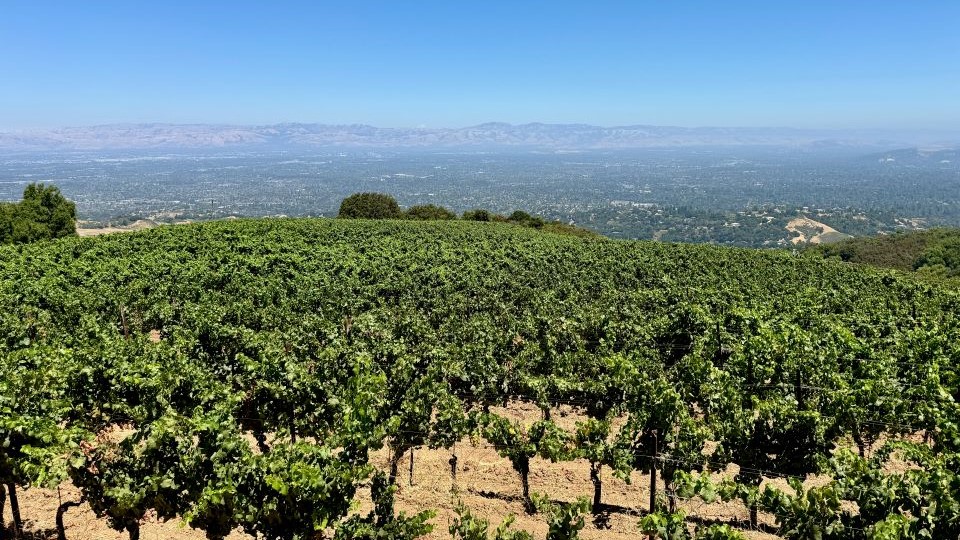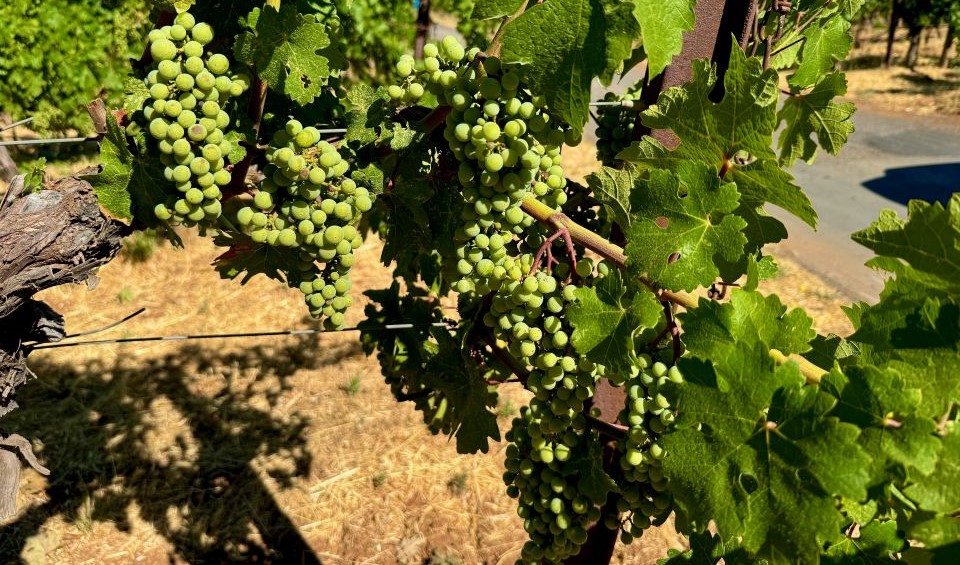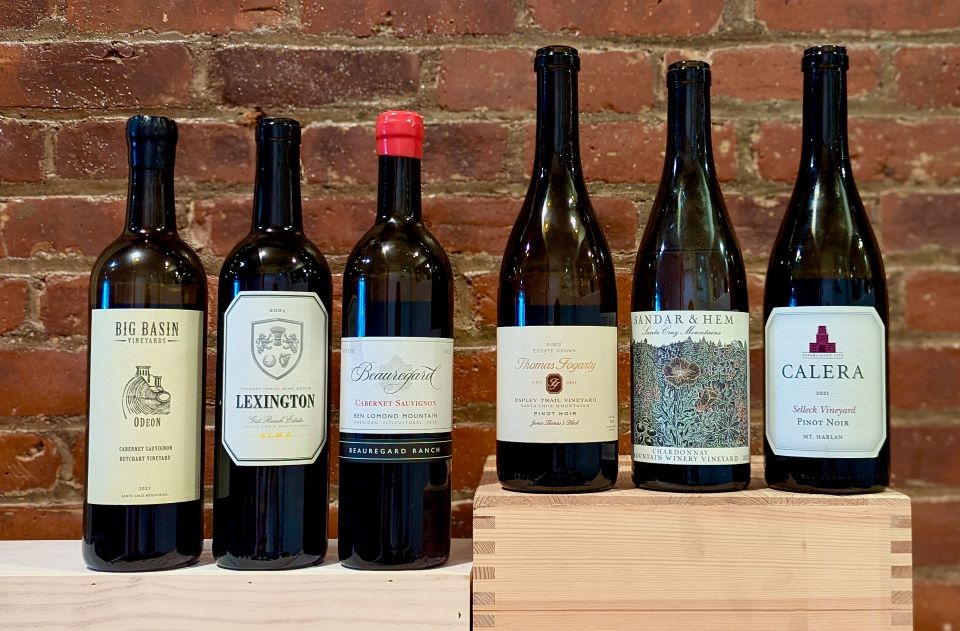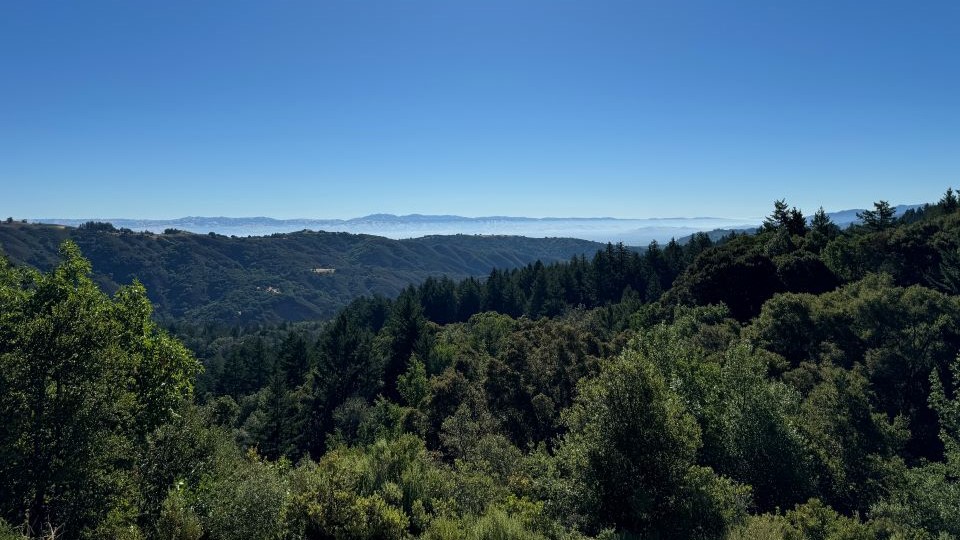Browse using the new Vinous website now. Launch →
Printed by, and for the sole use of . All rights reserved © 2015 Vinous Media
Santa Cruz Mountains – The Chameleon
BY BILLY NORRIS | OCTOBER 22, 2024
I’m sure Neal Martin would approve of me assigning a soundtrack for this report. If you have the means, drop the needle on Herbie Hancock’s “Chameleon” and read on…
The Santa Cruz Mountains is a confusing place.

Overlooking Silicon Valley from the top of Mount Eden.
It’s tough to navigate. Vineyards are tucked away behind thick pine and redwood groves so that you might never even know you were in a winegrowing region if you didn’t know you were in a winegrowing region. Winding mountain roads require a dose of Dramamine (a medication used to ease motion sickness) for those inclined toward queasiness, stretching short geographical distances into numbingly long treks. Visiting more than a few wineries in a single day requires a nearly Herculean effort. Rhys winemaker Jeff Brinkman warned me as I departed our meeting for a tasting at Mount Eden, “The GPS says 45 minutes, but plan on twice that. Do you have an SUV? It’s pretty steep.” My rental Chevy Malibu would have to suffice.
The climate is erratic and practically impossible to boil down into predictable regionality. It’s cold, damp, foggy and wickedly windy in some sites, occasionally even snowing at higher elevations in the winter. Conditions are endlessly sunny, dry and relentlessly warm in others.
The soils? Good luck counting them—you can thank the prehistoric convergence of two geologic plates and the San Andreas Fault for that.
Depending on who you ask, there may be four, five or six sub-regions, but their defining characteristics and boundaries are nebulous and up for debate. Of those, only one of them is officially designated, the nested Ben Lomond Mountain AVA.
Many producers who make wines from the Santa Cruz Mountains aren’t based there, including top names like Arnot-Roberts and Kutch in Sonoma, while many of the ones who are also make wines from elsewhere outside the area, such as Rhys with their Anderson Valley offerings and Ridge’s extensive range from Sonoma and beyond. The connection between producer and place can be difficult to nail down.
And the varieties? Chardonnay, Pinot Noir, Cabernet Sauvignon, Merlot, Syrah, Cabernet Franc, Chenin Blanc, Zinfandel, Nebbiolo and a smattering of others of all shapes and sizes come from every corner of the map. Current releases are never confined to a certain vintage because every producer marches to the beat of their own drummer.
At its heart, the Santa Cruz Mountains is a chameleon.
Looking east from the ridgeline at
Rhys, with the fog line that defines the Santa Cruz Mountains AVA visible in
the distance.
A Bit of Context
Winemaking has enjoyed a long history in the Santa Cruz Mountains, dating back to the mid-to-late 1800s. Legendary Burgundian Paul Masson set up shop around 1900, eventually selling his operation to Martin Ray due in part to the downturn caused by the nearly simultaneous arrival of Prohibition and phylloxera. Throughout the mid-1900s, more and more serious winegrowing operations took up residence. Gaining its formal designation in 1981, the Santa Cruz Mountains AVA was one of the first to be defined not by geographical boundaries but by topographical guidelines —following the fog line around the mountains at elevations between 400 and 800 feet.
Remarkably sparse vineyard plantings account for only 1,600 acres out of the AVA’s 480,000 total. Understanding the sub-divisions of the region can be challenging. While not officially recognized, the internally used sub-regions include Summit, Corralitos, Skyline, Saratoga, Coastal Foothills and the official Ben Lomond Mountain AVA. Rumblings of formal applications for AVA status for each sub-region are afoot, but it remains to be seen whether that will ever transpire. Several local owners and winemakers balk at the idea, expressing real concern over further muddying the water for consumers and citing the divergence of microclimates as a strong case against the validity of any broad-stroke designations.
The Meat and Potatoes
So, what generalizations can we make about the wines? For one, proximity to the Pacific Ocean and its influence are huge factors, bringing cooling marine winds that allow grapes to develop thicker skins and racy acidity. Elevation rises to nearly 3,000 feet in some spots, while exposure to the elements and orientation to the sun magnify a mountain tannin structure that permeates even the lightest wines. Proprietor and winemaker Robert Bergstrom of Sandar & Hem explains, “The character here is driven by climate, geology and aspect (orientation to the sun).” He adds, “Brightness, acidity and phenolics are the hallmarks of these wines. You can bet on super fresh, pure expressions with structure.” The wines here are often more classically styled and built on finesse while neither overtly rich nor exuberantly fruit-forward.
This report focuses primarily on the 2022s for Pinot Noir and Chardonnay and the 2021s for Bordeaux and Rhône varieties. I also tasted a select few 2023s (though most producers have yet to bottle those) and an assortment of older vintages that are either current releases or that producers shared for context.

Pre-veraison 2024 Cabernet Sauvignon in the Torre Vineyard of the Monte Bello estate.
The Growing Seasons
The 2022 growing season presented a unique set of challenges. Spring frost after bud break wiped out some crops entirely and knocked down yields for many producers. Rainfall was significantly higher than in 2021 but still below average. Moderate temperatures persisted through the summer, but the same multi-day 100-plus degree Labor Day heat spike that befell the rest of the state settled in right on cue at harvest time. Ryan Beauregard of Beauregard Vineyards explains, “The 2022 vintage made a lot of people not want to be winemakers anymore. It was brutal.” Thomas Fogarty winemaker Nathan Kandler echoes that sentiment. We had Pinot Noir that went from underripe to overripe in a blink. We had Chardonnay that shriveled up on the vine but was still weeks away from full ripeness. I’d never seen Chardonnay shrivel up at only 17 Brix.” Because of the separation and distance between vineyards, some producers fared fine, while others suffered mightily.
The 2022 Chardonnays are soft and generally lack the minerality, tension and depth readers have come to expect from the Santa Cruz Mountains. Chardonnay is capable of reaching stratospheric heights here, but the 2022s under-deliver. There are some notable exceptions, such as Model Farm’s 2022 Chardonnay PM Staiger Vineyard, Sandar & Hem’s 2022 Chardonnay Mountain Winery Vineyard and Rhys’ entire stable of 2022 Chardonnays.
The 2022 Pinot Noirs did better than the Chardonnays, with more immediacy and fruit generosity than is typical here, but they come up short of the depth and expressiveness present in the best years. Site characteristics still shine through, but they aren’t as amplified as usual—almost as if the master volume knob was turned down. However, Thomas Fogarty’s three fabulous 2022 Pinot Noirs from Rapley Trail Vineyard and Rhys’ full range of Pinots clearly missed the memo on the challenging season, venturing into the territory of exceptional.
Regardless of variety, the 2021s are compelling across the board. The result of punishingly dry conditions with slightly cooler temperatures at harvest, the 2021s display the hallmarks of an even, relatively stress-free season with long hangtimes. Bordeaux varieties, in particular, deliver at the highest level, balancing vibrant, delineated fruit, polished tannins and lively acids. Ridge’s 2021 Monte Bello is an instant classic, as is Mount Eden’s 2021 Cabernet Sauvignon Estate Bottled. Big Basin’s 2021 Cabernet Sauvignon Odeon Betchart Vineyard and Lexington Wine Co.’s 2021 White Blend Alma Gist Ranch Estate also punch above their weight. The 2021 Pinot Noirs, most of which Antonio Galloni covered in last year’s report, Santa Cruz Mountains - California's Hidden Gem, show equally impressive concentration and layered personalities, with Mount Eden’s just-released 2021 Pinot Noir Estate Bottled one of the best editions in recent memory. The 2021 Chardonnays? Also fantastic. Once again, Mount Eden scores top marks for the 2021 Chardonnay Estate Bottled. Rhône varieties, most notably the 2021 estate Syrahs from Big Basin, are deep, brooding and concentrated, excelling in the drought conditions and clearly announcing a sense of place.
All signs point to 2023 being another one for the books, as a long, cool, even year with no adverse events allowed sites to express their full potential and winemakers to take their time making decisions. The wines I’ve tasted so far have been quite good, although it’s still too soon to make sweeping proclamations of quality.

Standouts from 2021 and 2022 beyond the usual suspects.
The Chameleon
It’s not unusual to focus solely on a region’s power players and marquee producers—especially when they’re consistently great—but that also means it’s easy to miss the forest for the trees. In a place like the Santa Cruz Mountains, where a unified identity is neither blatantly obvious nor clearly communicated to the wine-drinking public, you have to look under the hood to understand the true nature of the place.
The strongest asset here is a core of capable, scrappy, adaptable, quality-minded producers who utilize the region’s diversity to succeed in spite of adversity. They change colors as necessary to blend in with their environment—like chameleons—churning out wines of precision, transparency and value year after year without much outside recognition or glory. John Benedetti of Sante Arcangeli refers to it as the “phalanx of quality”—a tight-knit group of winemakers tirelessly dedicated to pursuing excellence by holding one another accountable for the quality of their collective work. Their goal is simple: to elevate the region on the world stage. All you have to do is look—they’re always there, and their voices are getting louder.
As we have done in the past, this report also contains reviews from locations outside the Santa Cruz Mountains, including Calera’s noteworthy 2021 Pinot Noirs from Mt. Harlan and Ridge’s extensive array of 2022s from Sonoma. We have also added Antonio’s reviews of the 2022s from Rhys and the 2017s from Clos de la Tech, which he tasted earlier this year as we transitioned into my coverage of the region. Lastly, readers can search reviews of Santa Cruz Mountains wines from producers based outside the region published earlier this year here.
I tasted the wines for this report during a visit to the Santa Cruz Mountains in July 2024 and in subsequent tastings in both our New York office and my home office in Florida in September and October 2024.
© 2024, Vinous. No portion of this article may be copied, shared or re-distributed without prior consent from Vinous. Doing so is not only a violation of our copyright, but also threatens the survival of independent wine criticism.
You Might Also Enjoy
Santa Cruz Mountains – California’s Hidden Gem, Antonio Galloni, November 2023
Santa Cruz Mountains: The Compelling 2018s & 2019s, Antonio Galloni, May 2022
Santa Cruz Mountains: Wines of Breathtaking Pedigree, Antonio Galloni, September 2020
Exploring the Santa Cruz Mountains, Antonio Galloni, October 2019
Show all the wines (sorted by score)
- Alfaro Family Vineyards
- Alta Heights
- Beauregard Vineyards
- Big Basin Vineyards
- Birichino
- Calera
- Centennial Mountain
- Clos de la Tech
- Domaine Eden
- Farm Cottage Wines
- Kathryn Kennedy Winery
- Lester Estate Wines
- Lexington Wine Co.
- Madson
- Maison Areion
- Mindego Ridge Vineyard
- M. Mathis Winegrower
- Model Farm
- Mount Eden Vineyards
- Neely
- Odonata
- Rhys
- Ridge
- Sandar & Hem
- Santa Cruz Mountain Vineyard
- Sante Arcangeli
- Sarah's Vineyard
- Soquel Vineyards
- Thomas Fogarty Winery

